|
|
Printing the Nozzle Check Pattern (Mac OS X) MP160 / MP180 / MP460
| Article ID: ART126734 |
| |
Date published: 05/12/2015 |
| |
Date last updated: 11/04/2015 |
Description
The following contains instructions to check the nozzles for poor print quality and perform cleanings of the print head nozzles as necessary.
Solution
Checking / Cleaning The Print Head Nozzles (Mac OS X)
The following contains instructions to check the nozzles for poor print quality and perform print head nozzle cleanings. If print results are faint or streaks are printed, the print head nozzles may be clogged. To improve print quality, perform print head cleanings or print head deep cleanings.
Caution: Only used the approved methods below to clean the print head. Use of other methods may further clog the nozzles on the print head and may cause permanent damage the print head.
Note: It is important to check the cleaning results by printing Nozzle Check Pattern after each cleaning. Cleaning and Deep Cleaning consumes a certain amount of ink. Only perform a cleanings when necessary.
- Open Applications, Utilities, and double-click the 'Printer Setup Utility' icon.
Note : The name of Printer Setup Utility varies according to the Mac OS X version. When your Mac OS X version is older than 10.3.x, double-click 'Print Center'.
- In the Printer List, select the printer name you are using, and (depending on Operating System version) click 'Utility' or 'Maintenance' in the toolbar.
Note : If the printer name is not displayed, click 'Add' to detect the printer you are using.
If the printer name is still not displayed, confirm that the cable connects the printer to the computer and the printer is powered on; then, in the Printer List pop-up menu, select the connection condition in which the printer is actually connected.
- From the pop-up menu, select 'Test Print'.
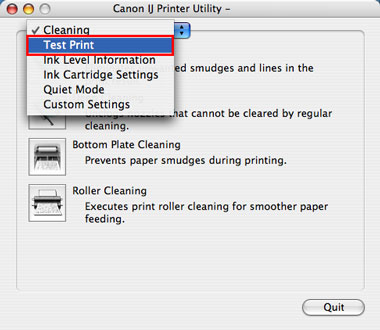
The layout of the Maintenance sheet varies depending on the printer you are using.
- Click the 'Nozzle Check' icon.

The layout of the Maintenance sheet varies depending on the printer you are using.
- After Checking that letter-size plain paper is set in the auto sheet feeder (ASF), click 'Print Check Pattern'. The nozzle check pattern printing will start.
Note: By clicking Initial Check Items before clicking Print Check Pattern, you can see the specific confirmation items in Nozzle Check.

- Examine the nozzle check pattern output.
When the output is normal:
Black ink: The grid pattern is regular without missing lines.
Color ink: White streaks are not visible in the pattern.
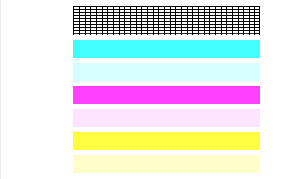
The pattern may vary depending on the printer.
When the output is not normal:
<Case A>
No color is printed. (Nothing appears on the output.)
<Case B>
There is any color which is not printed at all. (In the sample below, black ink is not printed at all.)
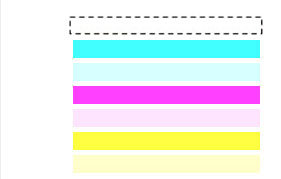
- The pattern may vary depending on the printer.
<Case C>
There are missing lines partially in the pattern for the black ink.

<Case D>
There are white streaks in the color ink pattern.

- Determine whether the pattern is normal or not, and perform the following:
-
- When the output is normal, click 'Quit' to finish the pattern check.
- When the output is not normal, click 'Cleaning' to perform print head cleaning.
Note: When printing a Nozzle Check Pattern from a printer which does not use a black ink cartridge, the Black pattern will not be printed on the paper and the BK pattern will not appear in the Pattern Check window.
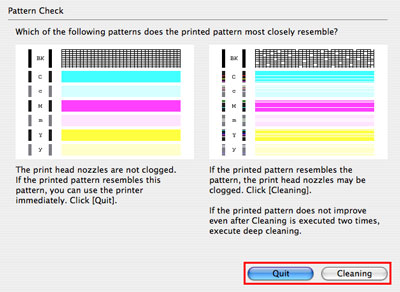
The pattern may vary depending on the printer.
- Click 'OK'. Print head cleaning starts.
Note:
* Print head cleaning consumes a certain amount of ink. Do print head cleaning only when necessary.
* By clicking Initial Check Items before clicking Print Check Pattern, you can see the specific confirmation items in Nozzle Check.

The Power lamp will blink and print head cleaning of the print head nozzles starts. The blink stops when print head cleaning is over.
Until print head cleaning completes, do not try other operations. Print head cleaning will take about 60 seconds.
- Print the Nozzle Check Pattern to examine the print head status.
- Confirm that sheets of A4 or letter size plain paper are loaded in the auto sheet feeder, and click 'Print Check Pattern'. Nozzle check pattern printing will start.
Note: By clicking Initial Check Items before clicking Print Check Pattern, you can see the specific confirmation items in Nozzle Check.

- Examine the printed Nozzle Check Pattern. The examination method is the same as the step 5 and 6.
- Perform print head cleaning again. (Same as steps 8 to 11.)
- If the pattern is still abnormal, perform print head deep cleaning.
Note: Print head deep cleaning consumes a larger amount of ink than normal cleaning. Perform print head deep cleaning only when necessary.
Print Head Deep Cleaning:
- From the pop-up menu, select 'Cleaning'.

The layout of the Maintenance sheet varies depending on the printer you are using.
- Click 'Deep Cleaning'.
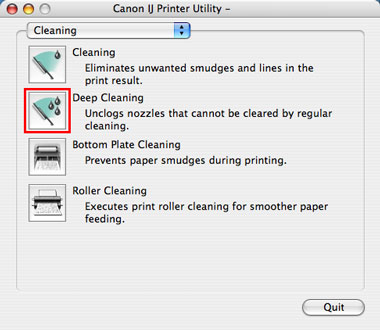
The layout of the Maintenance sheet varies depending on the printer you are using.
- Click 'OK'. Print head deep cleaning starts.
Note: By clicking Initial Check Items before clicking Print Check Pattern, you can see the specific confirmation items in Nozzle Check.
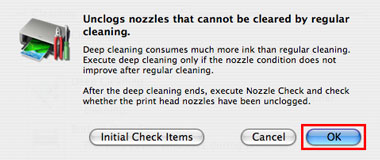
The Power lamp will blink and print head cleaning of the print head nozzles starts. The blink stops when print head cleaning is over.
Until print head cleaning completes, do not try other operations. Print head cleaning will take about 2 to 3 minutes.
- Print a Nozzle Check Pattern and examine it.
- Perform Deep Cleaning again if necessary.
- If the print quality does not improve, turn off the printer and let it sit for 24 hours or more, then perform Deep Cleaning again. The wait time may allow dried ink in clogged print head nozzles to liquify, and resolve the problem.
- If the print quality does not improve, replace the ink cartridge(s).
|